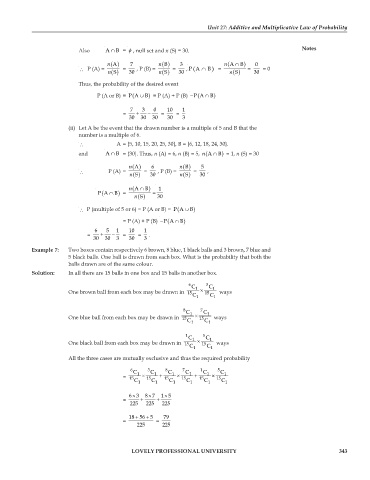Page 348 - DECO504_STATISTICAL_METHODS_IN_ECONOMICS_ENGLISH
P. 348
Unit 27: Additive and Multiplicative Law of Probability
Also A ∩ B = φ , null set and n (S) = 30. Notes
A
B
n ( ) 7 n () 3 n ( B )A ∩ 0
∴ P (A) = = , P (B) = = , ( ∩ B ) = = = 0
PA
n () S 30 n () S 30 n () S 30
Thus, the probability of the desired event
)
P (A or B) = ( PA ∪ B = P (A) + P (B) PA ∩ ( B )
−
7 3 0 10 1
= + − = =
30 30 30 30 3
(ii) Let A be the event that the drawn number is a multiple of 5 and B that the
number is a multiple of 6.
∴ A = {5, 10, 15, 20, 25, 30}, B = {6, 12, 18, 24, 30}.
)A ∩
and A ∩ B = {30}. Thus, n (A) = 6, n (B) = 5, ( n B = 1, n (S) = 30
B
n () 6 n () 5
A
∴ P (A) = = , P (B) = = ,
n () S 30 n () S 30
n ( B )A ∩ 1
)
(
PA ∩ B = =
n () S 30
∴ P (multiple of 5 or 6) = P (A or B) = ( PA ∪ B )
= P (A) + P (B) PA− ( ∩ B )
6 5 1 10 1
= + − = = .
30 30 3 30 3
Example 7: Two boxes contain respectively 6 brown, 8 blue, 1 black balls and 3 brown, 7 blue and
5 black balls. One ball is drawn from each box. What is the probability that both the
balls drawn are of the same colour.
Solution: In all there are 15 balls in one box and 15 balls in another box.
6 C 1 3 C 1
One brown ball from each box may be drawn in 15 × 15 ways
C 1 C 1
8 C 1 7 C 1
One blue ball from each box may be drawn in 15 × 15 ways
C 1 C 1
1 C 1 5 C 1
One black ball from each box may be drawn in 15 × 15 ways
C 1 C 1
All the three cases are mutually exclusive and thus the required probability
6 C 3 C 8 C 7 C 1 C 5 C
= 15 1 × 15 1 + 15 1 × 15 1 + 15 1 × 15 1
C 1 C 1 C 1 C 1 C 1 C 1
×
×
×
63 8 7 1 5
= + +
225 225 225
+
+
18 56 5 79
= =
225 225
LOVELY PROFESSIONAL UNIVERSITY 343

